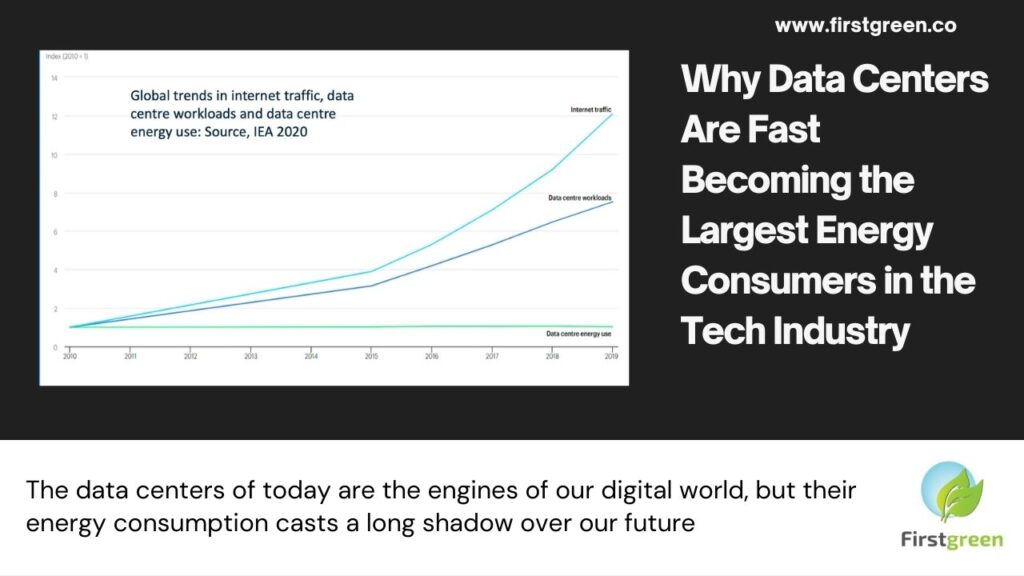“The data centers of today are the engines of our digital world, but their energy consumption casts a long shadow over our future.”

Data centers are the backbone of our digital world, powering everything from cloud services to social media, online banking, and e-commerce. As the digital landscape continues to expand, so does the energy footprint of these crucial infrastructures. Today, data centers are responsible for approximately 1% of global electricity consumption, which translates to around 200 TWh per year(Data Centres and Energy…). This sector’s rapid growth is driven by the increasing demand for digital services, cloud computing, and the Internet of Things (IoT), among other data-intensive technologies.
The Energy-Hungry Giants: What Drives Data Center Energy Consumption?
Data centers consume vast amounts of energy due to several key components, each playing a critical role in maintaining the facility’s operations:
- Servers: These are the heart of any data center, performing the computing tasks required to process and store data. Servers need continuous power to function and generate significant amounts of heat, necessitating further energy use for cooling.
- Cooling Systems: To prevent overheating, data centers rely on sophisticated cooling systems, including air conditioning units, water cooling, and even advanced techniques like liquid immersion cooling. Cooling typically accounts for 30-50% of a data center’s total energy consumption.
- Uninterruptible Power Supplies (UPS) and Power Distribution Units (PDUs): These systems ensure that data centers remain operational even during power outages. However, they also consume energy themselves, further adding to the overall footprint.
- Lighting and Security Systems: Although these contribute less to the total energy usage, they are essential for the day-to-day operations of the facility.
Why Is This Sector Growing So Quickly?
The explosion in data center energy consumption is fueled by several global trends:
- Digitalization of Services: More businesses and governments are digitizing their operations, increasing the demand for data storage and processing.
- Cloud Computing: The shift to cloud-based services, which require massive data centers, is a significant driver of energy consumption.
- IoT and AI Technologies: The proliferation of IoT devices and AI applications necessitates more data processing, further increasing energy demands.
- Increased Data Traffic: With the rise of high-definition video streaming, online gaming, and social media, global internet traffic is skyrocketing, leading to higher energy consumption in data centers.
Initiatives to Reduce Data Center Energy Consumption
Given the environmental impact, there is a growing focus on reducing the energy consumption of data centers. Some of the key initiatives include:
- Energy Efficiency Improvements: Advances in processor technology and server virtualization are enabling data centers to do more with less energy. Companies are investing in energy-efficient servers and adopting practices such as hot aisle/cold aisle containment to optimize cooling.
- Renewable Energy: Many data centers are transitioning to renewable energy sources such as solar, wind, and hydroelectric power. For example, Google and Apple have committed to powering their data centers with 100% renewable energy.
- Carbon Offsetting: Some data centers are investing in carbon offset projects to compensate for their emissions. This includes funding reforestation projects or supporting renewable energy development in other regions.
- Innovative Cooling Technologies: Emerging cooling technologies, such as liquid immersion cooling and free cooling (which uses ambient air instead of air conditioning), are helping to reduce the energy required for cooling.
- Circular Economy Practices: Initiatives like reusing waste heat from data centers for district heating or powering nearby facilities are also gaining traction.
Towards Carbon Neutral Data Centers
The ultimate goal for the data center industry is to achieve carbon neutrality. To reach this ambitious target, the following strategies are crucial:
- Commitment to Science-Based Targets: Aligning with global climate goals, data centers can adopt science-based targets to reduce their carbon footprint in line with the Paris Agreement. The ICT sector has already outlined a pathway to reduce emissions by 53% by 2030(Data Centres and Energy…).
- Climate Neutral Data Centre Pact: Launched in 2021, this industry-led initiative, supported by the European Commission, aims to make data centers climate-neutral by 2030. The pact includes commitments to energy efficiency, renewable energy, water conservation, and the adoption of circular energy systems(Data Centres and Energy…).
Conclusion
As the digital world continues to grow, so does the energy demand of data centers. However, through innovative technologies, renewable energy adoption, and global commitments to carbon neutrality, the industry is on a path to a more sustainable future. By continuing to prioritize energy efficiency and carbon reduction strategies, data centers can power our digital lives without compromising the planet’s health.
